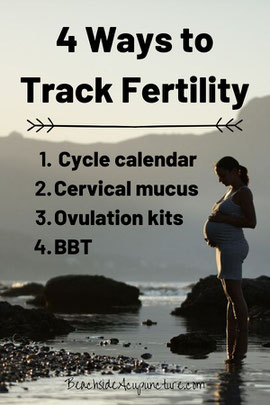
This post contains affiliate links, meaning Beachside Community Acupuncture PLLC may receive a small commission for purchases made through certain links at no additional cost to you. (In other words, you support us in a small way when you buy the products that we highly recommend and would use ourselves!) Click here to view our full disclosure policy.
The female body follows a set rhythm each month with a cycle that can be divided into the four stages of menstruation, follicular phase, ovulation, and luteal phase. If you have been trying to conceive naturally without success, tracking your cycle and making sure to have sex during your most fertile time will make you more aware of your body and increase your chances of getting pregnant. Read through each tracking method below and choose one (or more!) to use to better understand your fertility picture.
1. Count Days
The female cycle follows a set pattern:
- Menstruation: Your period, the first full day of which is your cycle's Day 1
- Follicular phase: The time between your period and ovulation during which follicles are growing, one of which will be released as an ovum (better known as an egg)
- Ovulation: The release of an egg
- Luteal phase: The time between ovulation and your next period during which the fertilized egg implants in the uterine lining
Medical textbooks will often simplify this cycle - meaning period start (Day 1) to period start (new Day 1) - by stating it lasts 28 days total with ovulation occurring in the middle at Day 14. However, every body is different, and many are not textbook perfect. Think of your own cycle: Were there months that your period came more or less than 28 days after the last one? Similarly, not everyone ovulates exactly in the middle of her cycle, so tuning into your body will give you a better idea of exactly when you ovulate. If you notice a slight pinch in your lower abdomen, breast soreness, or other symptoms, take note of them! Over time you may notice a pattern and find that you tend to ovulate earlier or later than your cycle's halfway point. (If you don't experience any symptoms around ovulation, you can use the next tracking indicator instead.)
You can easily enter all of this information into your planner or traditional calendar, but many of our patients prefer fertility apps, of which there are quite a few. Research various options and choose one that seems to fit you best, keeping in mind you can always change to another one if you don't like it. Apps that track the days of your cycle can illuminate patterns in the way your body operates and will often estimate when ovulation occurs for you. Some do this only by counting days and following the midpoint rule, but others will take information about your signs and symptoms of ovulation and use it in their algorithms to better predict your fertile times. Find one that allows you to enter as much about yourself as possible to get the most accurate estimates and have sex during your most fertile days.
2. Look at Cervical Mucus
You probably know that your reproductive hormones ebb and flow throughout your cycle - i.e. estrogen dominates the follicular phase and progesterone governs the luteal phase, or put in Chinese medicine terms, yin is more present in the follicular phase and yang in the luteal phase - but have you noticed that your cervical mucus (CM) also undergoes set changes each month as well? CM can be analyzed as discharge that can be seen in your underwear, on toilet paper after wiping, or when washing yourself, and it follows this pattern:
- Unnoticeable during menstruation
- Increasingly whiter and creamier after menstruation
- Thinner and clearer - often described as watery or "raw egg white" in consistency - leading up to ovulation
- Increasingly thicker and whiter again until menstruation
Being mindful of how your CM changes will give you more insight into your body, and noting when you notice egg white discharge on your calendar will help you (or your app) better predict your most fertile times. Sperm can live in the body for a few days, so it's best to begin having sex as soon as you see your CM start to become watery.
3. Use Ovulation Kits
Also called ovulation predictors and ovulation tests, ovulation kits detect higher levels of luteinizing hormone (LH) and sometimes estrogen, both of which indicate that ovulation will happen in the next few days (and that you should begin having sex for a better chance of conceiving). If you know approximately when you should be ovulating based on the other tracking methods above, these kits can help you more accurately pinpoint exactly when you will be ovulating based on your hormone levels that cycle. They come in a variety of forms, the most basic resembling a pregnancy test in that you urinate on a stick, and they can be found online or in most drug stores.
4. Measure Basal Body Temperature
Tracking basal body temperature (BBT) will give you the most information about your body, but it also requires the most amount of work! BBT undergoes predictable changes throughout your cycle - it's amazing how many things do, right? - and if you commit to measuring it, you should see this pattern:
- Menstruation: 97.3-97.8 degrees (a drop of 1.0 degree from the highest temp in the previous luteal phase)
- Follicular phase: 97.2-97.6 degrees with a slight drop at the end
- Ovulation: jump of 0.5-1.0 degree over a day or two
- Luteal phase: 97.8-98.4 degrees
Measuring BBT just requires buying a BBT thermometer - different from a regular thermometer because it's more precise at lower body temperatures and usually around $10 at most drug stores - and recording your daily temperature on a paper grid or in an app. The more difficult part is following the parameters required to get an accurate reading. BBT should be taken first thing on waking, before you even get out of bed. (Keeping your thermometer next to your bed minimizes the amount of movement that needs to happen before your temperature is taken.) Ideally, this would happen at the same time each day after you've had at least four hours of uninterrupted sleep, meaning no bathroom breaks or waking up for any other reason should occur before you wake because they can influence your body's resting temperature reading (BBT). Mouth breathing, feeling sick, travel, and certain medications can affect your readings.
If you can commit to tracking BBT, you'll have a lot more information that you can use for yourself - i.e. to pinpoint ovulation - or give to your healthcare practitioners to develop a treatment plan to even out imbalances that appear in your charts. If it seems like too much work but you like the idea of knowing exactly how long each of your phases lasts, there are companies that sell "watches" that automatically measure the temperature of your skin at a set time each morning and send it to their corresponding app. These readings won't produce a true BBT chart but will give you information about fertile times based on temperature fluctuations. We don't advocate being in constant contact with technology, but it is an option.

This may seem like a lot of information, but it all boils down to being very mindful of your body and working with it to give yourself the best opportunity to conceive. Stress lowers your chances of getting pregnant, so pick a tracking method that is manageable with your lifestyle and have faith that the steps you're taking to improve your fertility - eliminating xenoestrogens, receiving acupuncture treatments, etc. - will work out for you in the long run. A healthy body wants to conceive and anything you can do to take care of yourself will enhance your reproductive health as well.

Kathleen Ellerie is a Licensed Acupuncturist and the owner of Beachside Community Acupuncture. She loves providing affordable acupuncture to the residents of Addison, Dallas, and Farmers Branch, Texas, and educating the general public on how acupuncture and Traditional Chinese Medicine can treat everything from pain to infertility to stress and beyond. Click "Book Now" at the top of this page to book an appointment or feel free to contact her at (214) 417-2260.








